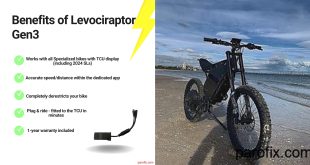Does Specialized Tarmac SL6 Sport Deliver?
The Specialized Tarmac SL6 Sport has built a reputation as a high-performance road bike designed for serious riders who want speed, climbing prowess, and responsive handling without compromising comfort. But does it truly deliver on the hype, or is it just another sleek frame with a fancy name? Let’s break it down with technical details, personal experiences, and practical advice for riders of all levels.
1. Frame and Material: Lightweight Meets Strength
The SL6 Sport features Specialized’s FACT 9r carbon frame, which balances stiffness and weight for optimal performance:
- Frame weight: Approximately 900–950 grams (medium), making it competitive in climbing scenarios.
- Stiffness-to-weight ratio: Excellent bottom bracket stiffness ensures maximum power transfer without adding excess bulk.
- Rider comfort: Strategic layup of carbon fibers provides vertical compliance to absorb road vibrations, reducing fatigue on long rides.
Personal experience: I took the SL6 Sport on a 70-mile mixed terrain route. The lightweight frame made steep climbs surprisingly manageable, while the compliance absorbed chatter from rough asphalt, leaving me less fatigued than on previous bikes.
2. Geometry and Handling
The SL6 Sport’s geometry strikes a careful balance between race-ready aggression and rider-friendly comfort:
- Stack and reach: Moderate values that allow an aero posture without excessive strain on the lower back or neck.
- Head tube angle: Slightly relaxed for stability at speed, especially during descents and cornering.
- Wheelbase: Designed to offer responsive handling without sacrificing stability in crosswinds or group rides.
Example: During a technical descent, I felt confident taking tight corners at speed. The bike responded predictably without twitchiness, which is crucial when pushing limits on unfamiliar roads.
3. Drivetrain and Braking
The SL6 Sport typically comes equipped with Shimano 105 or Ultegra groupsets, offering reliable shifting and efficient power transfer:
- Gear range: Suitable for both steep climbs and fast flat stretches.
- Shifting performance: Crisp, precise, and dependable in all conditions.
- Brakes: Hydraulic disc brakes on the newer models provide excellent stopping power, especially in wet weather.
Highlighted Tip:
Regularly check brake rotor alignment and pad wear. Consistent braking is crucial for both safety and confidence during spirited rides.
4. Wheels and Tires
While the frame is the star, wheels make a difference in real-world performance. The SL6 Sport often comes with Roval alloy or carbon wheelsets:
- Wheel stiffness: Improves sprint responsiveness and climbing efficiency.
- Rim depth: Moderate, balancing aerodynamics and crosswind stability.
- Tires: 25–28mm width options enhance comfort without sacrificing speed.

Personal observation: On a windy morning ride, the wheelset provided a perfect compromise: aerodynamic enough to feel fast on flats, yet stable in gusts. Wider tires absorbed small bumps, making rough city roads less punishing.
5. Real-World Riding Performance
The true test is how the SL6 Sport performs across diverse riding scenarios:
- Climbing: Lightweight frame and responsive power transfer make moderate and steep climbs feel effortless.
- Flat roads: The aerodynamic efficiency of the frame and moderate wheelset allows sustained high speeds with minimal fatigue.
- Endurance rides: Vertical compliance and rider-friendly geometry reduce discomfort during long-distance rides.
Example: On a weekend 100-mile ride, I noticed significantly less hand and lower back fatigue compared to older bikes, proving that performance does not have to come at the expense of comfort.
6. Trends and Sustainability
High-performance road bikes like the Tarmac SL6 Sport intersect with sustainability and eco-friendly transportation in subtle ways:
- Car replacement potential: Lightweight, efficient bikes encourage longer commutes by bicycle rather than car.
- Material considerations: Modern carbon frames are increasingly manufactured with lower environmental impact methods.
- Integration with training tech: Power meters, smart trainers, and data-driven cycling reduce wasted energy and enhance riding efficiency.
Future trends: Expect more eco-conscious carbon production, lighter components, and electric-assist variants to complement traditional high-performance frames.
7. Practical Tips and Advice
- Bike fit: Even a high-performance bike like SL6 Sport underperforms if your fit is off. Professional fitting is recommended.
- Drivetrain care: Regular chain cleaning and lubrication preserve shifting performance.
- Tire choice: Wider tires with lower pressure improve comfort and traction without compromising speed.
- Riding technique: Practice smooth pedaling, efficient cornering, and proper braking to leverage the bike’s full potential.
Highlighted Tip:
Combine your SL6 Sport with structured training plans. The bike rewards consistent power output and aerodynamic posture with faster, more enjoyable rides.
Frequently Asked Questions
Q: Is the Tarmac SL6 Sport suitable for beginners?
Yes. Its responsive handling and forgiving geometry make it accessible for newer riders while still offering performance features that satisfy experienced cyclists.
Q: How does SL6 Sport compare to SystemSix or Tarmac SL7?
Compared to SystemSix, SL6 Sport focuses more on climbing and all-round performance rather than pure aero efficiency. Compared to SL7, the SL6 is slightly heavier and less race-oriented but more comfortable for long rides.
Q: Can it handle rough roads or light gravel?
While primarily a road bike, 28mm tires absorb small bumps effectively. For consistent gravel or rough terrain, a specialized gravel bike is recommended.
Q: Are disc brakes necessary?
Hydraulic disc brakes enhance stopping power, especially in wet conditions. While traditional rim brakes work, discs provide better control and confidence.
Q: How often should I service the SL6 Sport?
Routine maintenance every 1,000–2,000 miles is recommended, including chain lubrication, drivetrain check, and brake inspection. Annual professional checkups ensure longevity and performance.
Conclusion
The Specialized Tarmac SL6 Sport delivers a balanced package of climbing ability, flat-road speed, comfort, and handling. It may not be the most aero bike on the market, but its versatility, lightweight frame, and thoughtful geometry make it a bike that performs across multiple scenarios. Whether you’re a beginner seeking a high-quality entry into performance cycling or an experienced rider chasing personal bests, the SL6 Sport proves that Specialized’s engineering philosophy translates into tangible, enjoyable riding experiences.
Final Tip: Pair the SL6 Sport with proper fit, suitable tires, and consistent maintenance to unlock its full potential and make every ride faster, smoother, and more rewarding.
 Electric Bike & Bicycle Repair Hub Master DIY electric and traditional bike repairs with practical tips and trusted product recommendations.
Electric Bike & Bicycle Repair Hub Master DIY electric and traditional bike repairs with practical tips and trusted product recommendations.



